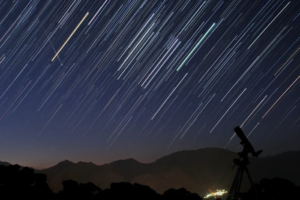The Eta Aquarids Meteor Shower and The Wonders of Meteors
Introduction
The universe is a vast expanse of celestial bodies, each with its unique characteristics and phenomena. One such fascinating spectacle is the Eta Aquarids meteor shower. Till date, we human beings have only discovered 5% of the universe, 95% is still left. In this blog, we will delve into the details of this meteor shower and explain what a meteor is and how it can be observed.
What is a meteor?
A meteor, often referred to as a shooting star or a falling star, is a streak of light in the sky caused by a meteoroid crashing through Earth’s atmosphere. Meteoroids are lumps of rock or iron that orbit the sun. Most meteoroids are small fragments of rock created by asteroid collisions. When a meteoroid enters Earth’s upper atmosphere, it heats up due to friction from the air. The heat causes gasses around the meteoroid to glow brightly, and a meteor appears.
How do meteors occur?
Meteors occur due to the interaction of meteoroids with Earth’s atmosphere. Here’s a detailed explanation:
- Meteoroids: Meteoroids are space rocks that range in size from dust grains to small asteroids. Most meteoroids are pieces of other, larger bodies that have been broken or blasted off. Some come from comets, others from asteroids, and some even come from the Moon and other planets. Some meteoroids are rocky, while others are metallic, or combinations of rock and metal.
- Entry into Earth’s Atmosphere: When meteoroids enter Earth’s upper atmosphere, they heat up due to friction from the air. The heat causes gasses around the meteoroid to glow brightly, and a meteor appears.
- Meteor Showers: Meteor showers occur when the Earth, in its orbit around the Sun, passes through debris left over from the disintegration of comets. As a comet nears the sun, a trail of dust and other debris burns off and remains in solar orbit. As Earth orbits the sun, it passes through this debris field spread across its path. Small bits burn up in the atmosphere, creating meteors.
- Comet Disintegration: When a comet enters the inner part of the solar system, heat from the sun causes ice on the comet’s surface to change from ice to gas, a process called sublimation. This produces a comet’s beautiful tail. The rocky debris, consisting of mostly sand-size particles, continues in an elongated orbit around the Sun close to that of its parent comet.
So, in essence, the occurrence of meteors is a result of the interaction of meteoroids (which are often debris from comets or asteroids) with Earth’s atmosphere.
The Eta Aquarids Meteor Shower
The Eta Aquarids meteor shower is strongly best viewed from the southern hemisphere or close to the equator. This meteor shower is active between April 15 and May 27 and peaks on the night of May 4 and the predawn hours of May 5. The chunks of space debris that create the Eta Aquarids come from a celestial icon: Halley’s Comet. The maximum rate for shooting stars in a clear sky will be about 50 per hour, according to the American Meteor Society (AMS). These fast meteors travel across the sky at about 41 miles (66 kilometers) per second.
How to See a Meteor Shower
Observing a meteor shower is a game of patience. Here are some tips to enhance your meteor-watching experience:
- Find a Dark Spot: Find an area outside which has a wide view of the sky and is away from bright lights.
- Time Your Viewing: Plan your trip such that you give yourself about 15–30 minutes to set up and let your eyes adjust to the dark.
- Dress Appropriately: Meteor watching can be a waiting game, so bring anything that will make your wait comfortable—blankets, reclining chairs, pillows, and warm beverages.
- Look Up and Around: Don’t look directly at Aquarius to see the meteors, as they will be visible across the night sky. Make sure to move your gaze around to nearby constellations.
Why are Eta Aquarids unique?
Eta Aquarids is unique because of its speed. The speed can go up to 66 Km/s. Fast speed leads to glowing tails, which last for several seconds to a few minutes.
Where should I look at the sky to find Eta Aquarids?
Eta Aquarids comes from the constellation Aquarius. Aquarius is also known as the water bearer, It was associated with the annual flood of the Nile during ancient Egyptian times. One of the brightest stars in this constellation is Eta Aquarii, Eta Aquarids appear at this part of the constellation.
Astroports from where we can see “Eta Aquarids”
Belur: The best time to see Eta Aquarids is at 3 AM on 5th May.
Sariska: The best time to see Eta Aquarids is at 3 AM on 5th May.
Dhela: The best time to see Eta Aquarids is at 3 AM on 5th May.
Nubra/Pangong Tso: The best time to see Eta Aquarids is at 2 AM on 5th May.
Conclusion
The Eta Aquarids meteor shower is a celestial event that offers a spectacular sight for stargazers. Understanding what a meteor is and how to observe a meteor shower can enhance this experience. So, mark your calendars for the next Eta Aquarids meteor shower, find a dark spot, and get ready to witness this astronomical marvel.
Watching the Eta Aquarids is a once-in-a-lifetime experience.
And Astroport Global is ready to make your experience remarkable and unforgettable.
Ready to join the cosmic fiesta? Head to Astroport locations – Astroport Sariska, Rajasthan Astroport Dwarasamudra, Karnataka, Astroport Ajmer, Rajasthan, Astroport Ashtamudi, Kerala, & Astroport Corbett, Uttarakhand for the Messier Marathon! Save the dates, gather your cosmic crew, and get ready to be awestruck by the celestial wonders.
To know more, chat with us on WhatsApp or Call us – +91-9278767700 [9-ASTRO-7700]











